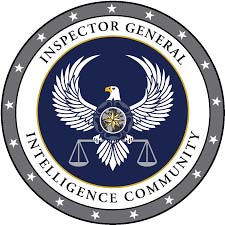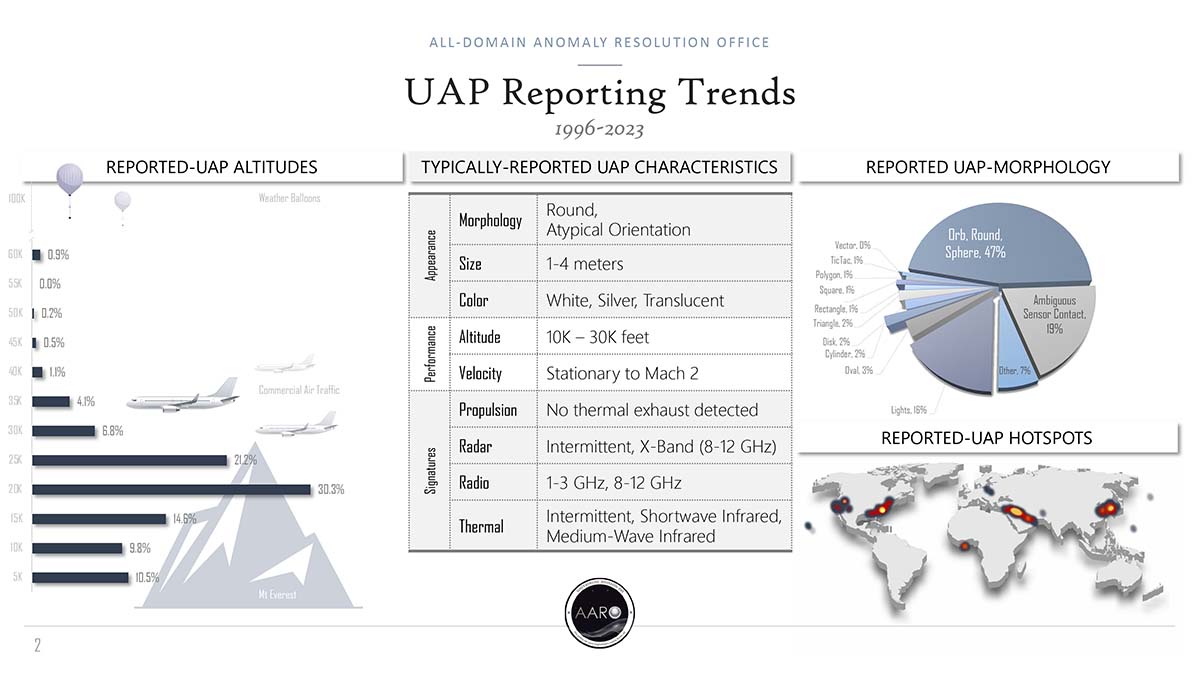Declassification Targets
Declassify UAP maintains the stance that it’s of paramount importance for the public to clearly articulate the specific types of information relating to Unidentified Anomalous Phenomena that we are aiming to see declassified.
Being specific allows us to hold our elected officials accountable for delivering results, in a way that remaining vague does not.
It also allows the public to clearly set expectations for officials across the DoD, Intelligence Community, and civilian agencies, while also showing these officials that we support going about UAP declassification in a responsible fashion that does not jeopardize legitimate national security interests.
Acknowledging basic facts about UAP cannot in and of itself be viewed as a threat to national security.
The possibility exists that some people within the national security apparatus may believe withholding UAP information is in the public and state’s best interest, based on the potential nature of the information – not necessarily what it may reveal about intelligence-gathering sources and methods.
If this is the case, it is wrong.
If it so happens that classified information about UAP implies or outright reveals something new to us about the nature of the world in which we already live, we will be the better for knowing it. Our world and its systems can and will adapt, and will be stronger in an environment of openness to the topic.

A Case in Point
Microorganisms and viruses are invisible lifeforms and self-replicating molecules that surround us, outside and in, every moment of our lives. They directly and ongoingly affect our health and well-being. People used to refer to these things as “demons,” because we didn’t know that the cause of various conditions was this ubiquitous invisible presence.

Only recently have we begun to learn that the microbiome living inside of us may have a significant impact on our emotional states.
In a manner of speaking: the tiny invisible creatures living inside of you, which you maintain a complex, subtle, not fully-understood, and lifelong relationship with, might be impacting your thoughts and emotions – possibly at this very moment.
Yet we go on, and ideally learn how to have a more productive relationship with our gut colonies.
It would be a shame, if the over-classification of UAP ended up being a coverup of something that by all appearances, impacts us significantly less in a day-to-day way than microorganisms do.
Declassification Target #1
Recorded Media Featuring UAP
Recorded media (photos and videos, in visual and infrared bands) clearly showing UAP exhibiting apparently anomalous characteristics & capabilities, such that the depicted objects can’t easily be written off as balloons, reflections/glare, common aircraft or UAVs, wildlife, aerial clutter, or other mundane explanations. This includes longer-duration and higher-resolution UAP videos than those declassified and released to date.
Recorded media featuring UAP can be responsibly declassified.
The Department of Defense releases high-quality recorded media associated with sensitive military operations and platforms on an ongoing basis. The DoD has demonstrated repeatedly that it is fully capable of scrubbing media file metadata and obscuring onscreen data overlays in a way that preserves the operational security of our armed forces and intelligence apparatus.
Recent examples include:
The selfie photo taken by a U-2 spy plane pilot flying near the Chinese Spy Balloon in February 2023 (days ahead of the three North American UAP shoot-downs, which received entirely different treatment).
Photos of the Chinese Spy Balloon post-shoot-down recovery operation (again, handled totally unlike the attempted recovery operations of the three UAP that were shot down in the days that followed).
Video of the collision between a Russian fighter jet and a US military drone over the Black Sea in March of 2023.
Video of the near-miss between a Chinese fighter jet and a US reconnaissance aircraft in May of 2023.
The Middle Eastern Metallic Sphere video captured by a US reconnaissance drone in July of 2022, shown by AARO director Dr. Sean Kirkpatrick during both the Senate UAP hearing that took place in April 2023, as well as NASA’s UAP Independent Study Team public meeting in May 2023.
There is no reasonable argument for withholding similar videos or still images that clearly depict the types of UAP that have already been described in official government UAP reports, and have already been shown in videos released to date by DoD such as FLIR, GIMBAL, GOFAST, and the Middle Eastern Metallic Sphere recording.
Likewise, there is no reasonable argument for withholding clear videos of UAP performing in ways that resemble what has already been described in official government UAP reports, relayed in detail by US Naval aviators and radar operators, and confirmed by Scott Bray, Deputy Director of Naval Intelligence at ONI, during his May 2022 House UAP hearing testimony.
Declassification Target #2
UAP Characteristics & Capabilities
Summarized descriptions of the apparent characteristics and capabilities of highly anomalous and outlier UAP (e.g. the 2004 USS Nimitz “Tic-Tac”) that have been captured by classified military and intelligence systems, including radar. This includes situations where such data appear to validate aviator observations and/or recorded media.
Inferences about apparent UAP material composition based on sensor data is an important characteristic that should be declassified. For instance, Dr. Sean Kirkpatrick of AARO has used the word “metallic” to describe spherical UAP that have been observed by the military around the world. The public should be told whether this means that the government has reason to believe these objects are actually made of metal (vs mylar or another metallic-appearing substance), which could potentially be derived from radar data. Knowing that UAP are made of metal is critical, as it all but rules out the possibility that such objects are actually balloons.
UAP characteristics & capabilities can be responsibly declassified.
It is absolutely possible for the US military and Intelligence Community to safely release summarized descriptions of the apparent characteristics and capabilities of truly anomalous UAP that have been captured by sensitive military and intelligence systems, because descriptions of events that have been captured using such systems have already been shared with the public.
Recent examples include:
US Space Command’s letter to Harvard astrophysicist Avi Loeb and his colleague Amir Siraj, confirming that the object now labeled IM1 that collided with the Earth in January 2014, initially identified by Loeb and Siraj by utilizing publicly-available data, was likely an interstellar object based on data gathered by highly-sensitive space-monitoring systems.
The US Navy’s confirmation that its highly-sensitive ocean-monitoring systems picked up the acoustic signature of the tragic implosion of OceanGate’s Titan submersible in June of 2023.
There is no reasonable argument for withholding basic information about UAP characteristics that has been collected by apparently reliable data-gathering systems, further validating what’s already been described in detail in reports, hearings, public accounts, as well as independent scientific analyses of events such as the 2004 USS Nimitz “Tic-Tac” incident.
Such confirmations, however, will be invaluable when it comes to motivating broad scientific interest in studying UAP, and stimulating the allocation of funding that public and private research efforts require. This does not require revealing raw data or the detailed operational capabilities of sensitive US military and intelligence collection platforms and systems.
Declassification Target #3
Intelligence Assessments of UAP
US Government (DoD, Intelligence Community, and civilian agency) and/or contractor intelligence assessments on the potential nature and origin of highly anomalous and outlier UAP such as the 2004 USS Nimitz “Tic-Tac”, including the possibility or likelihood of Extraterrestrial (ET), Non-Human Intelligence (NHI), or other paradigm-shifting explanations for what’s been observed.
Intelligence assessments of UAP can be responsibly declassified
A significant portion of the public already believes that there is a real possibility UAP represent something potentially paradigm-shifting in nature.
Legalistic statements from DoD officials that suspiciously avoid mention of existing US intelligence assessments on the nature and origin of UAP – an entirely different and fundamentally less-stringent standard of evidence than peer-reviewed scientific analysis – only create more widespread confusion and tension around this important topic, as well as distrust of government.
It’s time for the US Government and Intelligence Community to level with the public, and tell us what it thinks UAP might represent – especially those that appear to defy our experts’ understanding, and current engineering capabilities.
If it so happens such assessments indicate that what a large percentage of the public is already open to may indeed be the case, learning this will ultimately increase the public’s faith in our public institutions, not diminish it.
Declassification Target #4
UAP Retrieval, Research & Development, and Reverse-engineering / Exploitation Programs
Information on potential US Government (DoD, Intelligence Community, and civilian agency) and/or contractor UAP retrieval, research & development, and reverse-engineering/exploitation programs, such as those that have now been alleged by multiple whistleblowers who have testified before Congress, AARO, and the DoD and Intelligence Community Inspectors General.
Information about UAP Retrieval, R&D, and reverse-engineering programs can be responsibly declassified
Recent allegations of highly-classified US government and contractor UAP retrieval, R&D, and reverse-engineering programs, such as those made by former NGA, NRO, US Air Force, and UAP Task Force intelligence official David Grusch (who also reported his concerns through official Intelligence Community Inspector General and Congressional whistleblower channels), echo a longstanding collection of similar allegations made previously by credible government officials over the decades.
The public is well aware of such allegations at this point, and has speculated for half a century on this possibility. This degree of long-term speculation is unhealthy to a functioning democracy, and erodes the public’s trust in its important institutions, officials and service members across the US military and Intelligence Community, and our elected representatives.

The US Government needs to reveal, definitively, whether it or any of its contractors have taken into possession UAP materials or even somewhat-intact objects, and if so, offer at least general descriptions of what such material has revealed about the nature and origin of these objects. If no definitive finding has been made, it is better for the public to be aware that some uncertainty may exist, versus operating in the state of total uncertainty that is the status quo.
Declassification Target #5
UAP-related Public Influence Campaigns
Information on potential US Government (DoD, Intelligence Community, and civilian agency) and/or contractor public influence campaigns, Psychological Operations (PSYOP), or any other manipulation of public perceptions around the UAP issue, current or historical. This includes who initiated such potential campaigns, under what authority, to what ends, and which information presented to the public may have been contradicted by classified information and assessments.
Information about UAP-related public influence campaigns can be responsibly declassified
There have unfortunately been numerous occasions throughout history when the official institutions of the United States, and their leadership, have made massive errors in judgment when it comes to its civilian, military, and intelligence operations, as well as interactions with and information provided to American citizens. A number of these totally unethical actions and policies have risen to outright illegal activity, and have even led to large numbers of deaths and other casualties.
Some examples include:
The Tuskegee Syphilis Study conducted on African American men between 1932 and 1972 by the US Public Health Service (PHS) and the Centers for Disease Control and Prevention (CDC), which deliberately (and secretly) allowed treatable infections in test subjects to progress, in order for negative health effects of the disease to be observed (this led to the deaths of over 100 people).
The so-called Pentagon Papers, uncovered and revealed by the late Daniel Ellsberg, which made abundantly clear that the Vietnam War and other US military operations in Southeast Asia in the mid-20th Century were not being accurately (or at all) publicly reported by the US military in terms of their status, potential for success, and even the primary reasoning that motivated these operations.
The Iran-Contra Affair of the mid-1980s, a clandestine and illegal operation run by senior officials in the Reagan administration, who facilitated arms sales to Iran (under embargo by the US at the time) in order to fund a group of right-wing rebels in Nicaragua (which Congress had passed a law to prevent the financing of).
Highly misleading and inaccurate justifications for the United States and allied forces’ 2003 invasion of Iraq offered by Bush (43rd) administration officials to allies, the UN Security Council, and the public at large. The war led to the deaths of potentially millions of Iraqis, thousands of US and allied warfighters, cost taxpayers over two trillion dollars, and never uncovered any tangible evidence of ongoing Iraqi weapons of mass destruction (WMD) programs.
Clearly, the American people can weather learning about tragic mistakes made by our government, military, and Intelligence Community, including situations where the public has been totally and deliberately misinformed regarding official activities and findings.
If the public were to learn that we’ve been misinformed on the topic of UAP, not only will the republic survive this revelation, but it will allow us to turn the corner and move toward greater clarity and progress – certainly with regard to UAP, and perhaps more broadly.
Declassification Target #6
The February 2023 North American UAP Shoot-downs
Recorded media, summarized descriptions of characteristics & capabilities, and intelligence assessments specifically relating to the three totally unprecedented UAP shoot-downs across North America by NORAD/USNORTHCOM over consecutive days in February of 2023. This includes information about object retrieval attempts, and any potential cover-up of retrieved debris associated with the Prudhoe Bay Alaska, Yukon Canada, or Lake Huron shoot-downs.
Information about the February 2023 UAP shoot-downs can be responsibly declassified
Americans have the right to be told significantly more about the three unidentified objects that were brought down by the US military over North America one weekend in February 2023; the first time in the entire history of contemporary North American airspace defense operations that any kinetic actions have occurred.
We have the right to learn more about the appearance and characteristics of these specific objects, tantalizingly referred to by NORAD’s General VanHerck (who ran the shoot-down operations), which left the public with more questions than answers.
Despite what was likely General VanHerck’s sincere intention to answer reporters’ questions to the best of his ability given the context of classified operations, it is ultimately irresponsible for high-level US military officials to dangle the possibility that our fighter jets have shot down aliens on the order of the President, without offering any context for such statements or providing any followup information to the public.
Declassification Target #7
The November 2004 USS Nimitz “Tic-Tac” Incident
Recorded media, summarized descriptions of characteristics & capabilities, and intelligence assessments specifically relating to the USS Nimitz “Tic-Tac” incident of November 2004.
Information about the November 2004 USS Nimitz “Tic-Tac” incident can be responsibly declassified
The version of events the public is familiar with was seemingly verified by Scott Bray, Deputy Director of Naval Intelligence at ONI, during his May 2022 House UAP hearing testimony, when asked by Representative Rick Crawford of Arkansas:
“Do we have an example, can you cite a specific example of an object that can’t be explained as having been human made or natural?”
Bray responded:
“I mean, the example that I would say is still unresolved that I think everyone understands quite well [emphasis added] is the 2004 incident from Nimitz. We have data on that [emphasis added], and it simply remains unresolved.”
If the public already understands the contours of this event so well (including the possibility that the object moved at speeds well in excess of Mach 10 and then came to a hover – totally impossible for any known or even imaginable aircraft of human construction without being torn to bits), it stands to reason that we can be safely provided at least some additional level of detail about the object’s performance characteristics that were revealed by the data Bray referred to in his Congressional testimony.
Americans deserve a more detailed official accounting of the 2004 USS Nimitz “Tic-Tac” Incident, especially given the large volume of both official and unofficial information in the public domain concerning this astounding event.













